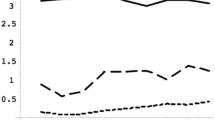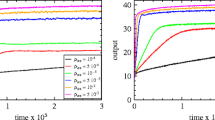Abstract
We extend an earlier model of innovation dynamics based on percolation by adding endogenous R&D search by economically motivated firms. The {0,1} seeding of the technology lattice is now replaced by draws from a lognormal distribution for technology ‘difficulty’. Firms are rewarded for successful innovations by increases in their R&D budget. We compare two regimes. In the first, firms are fixed in a region of technology space. In the second, they can change their location by myopically comparing progress in their local neighborhoods and probabilistically moving to the region with the highest recent progress. We call this the moving or self-organizational regime (SO). We find that as the mean and standard deviation of the lognormal distribution are varied, the relative rates of aggregate innovation switches between the two regimes. The SO regime has higher innovation rates, other things being equal, for lower means or higher standard deviations of the lognormal distribution. These results hold for increasing size of the search radius. The clustering of firms in the SO regime grows rapidly and then fluctuates in a complex way around a high value that increases with the search radius. We also investigate the size distributions of the innovations generated in each regime. In the fixed one, the distribution is approximately lognormal and certainly not fat tailed. In the SO regime, the distributions are radically different. They are much more highly right skewed and show scaling over at least two decades with a slope of almost exactly one, independently of parameter settings. Thus we argue that firm self-organization leads to self-organized criticality.
Similar content being viewed by others
References
Brock WA, Hommes CH (1998) Heterogeneous beliefs and routes to chaos in a simple asset pricing model. J Econ Dyn Control 22:1235–1274
Dosi G (1982) Technological paradigms and technological trajectories. Res Policy 11:147–162
Foray D, Grübler A (1990) Morphological analysis, diffusion and lock-out of technologies: ferrous casting in France and the FRG. Res Policy 19:535–550
Frenken K, Leydesdorff L (2000) Scaling trajectories in civil aircraft 1913–1997. Res Policy 29:331–348
Harhoff D, Narin F, Scherer FM, Vopel K (1999) Citation frequency and the value of patented inventions. Rev Econ Stat 81:511–515
Hill BM (1975) A simple general approach to inference about the tails of a distribution. Ann Stat 3:1163–1174
Nelson RR, Winter SG (1977) In search of a useful theory of innovation. Res Policy 6:36–76
Sahal D (1981) Patterns of technological innovation. Addison-Wesley, New York
Saviotti PP (1996) Technological evolution, variety and the economy. Edward Elgar, Cheltenham
Scherer FM (1998) The size distribution of profits from innovation. Ann d’Econ Stat 49/50:495–516
Scherer FM, Harhoff D (2000) Technology policy for a world of skew-distribution outcomes. Res Policy 29:559–566
Scherer FM, Harhoff D, Kukies J (2000) Uncertainty and the size distribution of rewards from innovation. J Evol Econ 10:175–200
Schumpeter JA (1939) Business cycles: a theoretical, historical and statistical analysis of the capitalist process. McGraw-Hill, New York (page numbers quoted in the text refer to the abridged version reprinted in 1989 by Porcupine Press, Philadelphia)
Silverberg G (2002) The discrete charm of the bourgeoisie: quantum and continuous perspectives on innovation and growth. Res Policy 31:1275–1289
Silverberg G, Lehnert D (1996) Evolutionary chaos: growth fluctuations in a Schumpeterian model of creative destruction. In: Barnett WA, Kirman A, Salmon M (eds) Nonlinear dynamics in economics. Cambridge University Press, Cambridge
Silverberg G, Verspagen B (2003a) Brewing the future: stylized facts about innovation and their confrontation with a percolation model. Eindhoven: ECIS Working Paper 80 http://www.tm.tue.nl/ecis/Working%20Papers/eciswp80.pdf
Silverberg G, Verspagen B (2003b) Breaking the waves: a Poisson regression approach to Schumpeterian clustering of basic innovations. Camb J Econ 27:671–693
Silverberg G, Verspagen B (2004) The size distribution of innovations revisited: an application of extreme value statistics to citation and returns measures of patent significance. Maastricht: MERIT Research Memorandum 2004-021, http://www.merit.unimaas.nl/publications/rmpdf/2004/rm2004-021.pdf, forthcoming in J Econom
Silverberg G, Verspagen B (2005) A percolation model of innovation in complex technology spaces. J Econ Dyn Cont 29:225–244
Sneppen K (1992) Self-organized pinning and interface growth in a random medium. Phys Rev Lett 69:3539–3542
Sornette D, Zajdenweber D (1999) The economic returns of research: the Pareto law and its implications. Eur Phys J B 8:653–664
Trajtenberg M (1990) A penny for your quotes: patent citations and the value of innovations. Rand J Econ 21:172–187
Winter SG (1984) Schumpeterian competition in alternative technological regimes. J Econ Behav Org 5:287–320
Author information
Authors and Affiliations
Corresponding author
Additional information
An erratum to this article can be found at http://dx.doi.org/10.1007/s11403-007-0023-1
Rights and permissions
About this article
Cite this article
Silverberg, G., Verspagen, B. Self-organization of R&D search in complex technology spaces. J Econ Interac Coord 2, 211–229 (2007). https://doi.org/10.1007/s11403-006-0008-5
Received:
Accepted:
Published:
Issue Date:
DOI: https://doi.org/10.1007/s11403-006-0008-5




